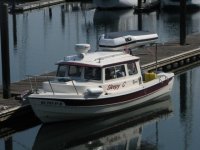This is how I tow single canoes behind my 22'. My system has evolved over a number of years.
1. Based on prior negative experiences, I have made water proof covers from light weight materials which run the entire length from bow to stern with SS snaps on the sides which go over the gunnels. The male snaps are fixed below the gunnels with a pop rivet gun about a foot apart. Easy to do.
The female portion of the SS snaps are fixed to the fabric, one at a time to match the male portion of the snaps which are already installed. It is not difficult to make it quite water resistant to cross chop or waves which hit amidships where the freeboard is lowest since the cover edges roll over the gunnel and water trying to come aboard just rolls back into the lake or ocean. Also, keeps rain out of the canoe. Without a good cover, a canoe can take on too much water and become a sea anchor in a very short time. Making a cover is not difficult to do It is a fun project.
2. Towing: Some advice. Most canoes have bow eyes at the top. This is not where you want to tow from. You can drill a hole midway down the bow stem and put in a ring,( I use a small SS carabiner for ease of removal) This is where your tow rope will lift the bow slightly and enhance your towing angle.
I tow from the aft cletes with a wishbone harness (commercial type - WestMarine has them) with a ball float to keep the line from getting into the propeller. Once underway the harness will not rub on the engine. I use a yellow tow line which floats. One end has a SS snap tied on and that end snaps on the float ring. The rest of the tow line is run back through the canoe ring and back to either aft clete.
Make enough extra tow rope so you can adjust your canoe distance. As you are towing, you can make your adjustments while underway, to and from. With this system your canoe will not yaw as much as if your tow line was tied to the bow. Also, if for what ever reason you need to separate your boat from the canoe, you just untie from the clete and let the floating rope slide through the canoe ring.
The C-Dory reverse chines and motor wake create a nice V which the canoes's bow can fit in while on plane. Johnj's illustration shows this nicely. Getting your canoe bow where it belongs requires someone to tend the tow line, which is why I use the system described above.
I keep my towing gear in a small bag for quick accessability.
I hope this is clear as mud!
Yellowstone

